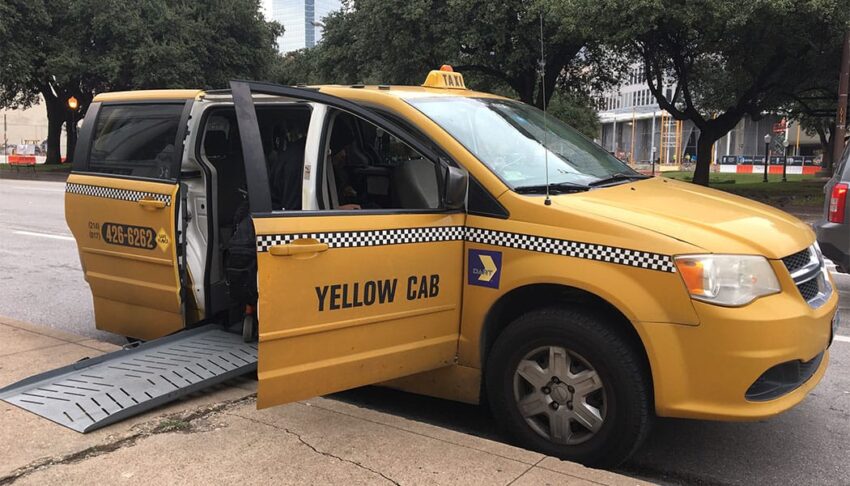Written by John Morris, WheelchairTravel.org., June 2, 2025
CLICK HERE to See Part One
Accessible Hotels in Dallas
Finding a wheelchair accessible hotel room in Dallas, Texas is easy! The Americans with Disabilities Act mandates that hotels offer rooms…
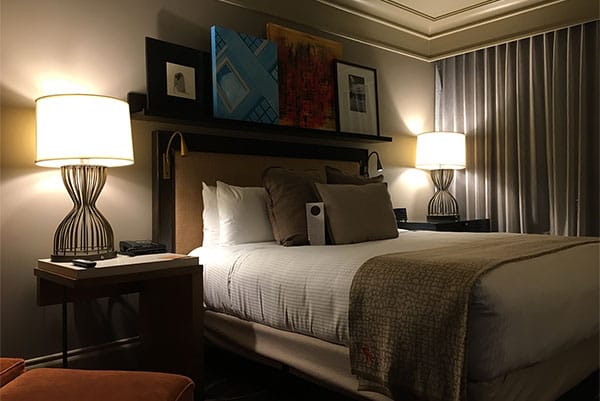
This page may contain affiliate links from some of my advertising partners. You don’t have to use these links, but I appreciate your support of my blog when you do. You can read my advertising disclosure here.
Finding a wheelchair accessible hotel room in Dallas, Texas is easy! The Americans with Disabilities Act mandates that hotels offer rooms with accessible tubs or roll-in showers.
Accessibility is generally better at the nicest hotels, and you’ll certainly find better accommodations at a Hilton or Marriott as opposed to a budget property or “fleabag motel.” I’ve taken the time to compile a list of hotels in Dallas with handicap accessible rooms and roll-in showers, across all price ranges. This is not a complete list of accessible hotels in the area. The hotels have not paid a fee to be listed here. Hotels listed in bold are properties I have stayed at myself – click the hotel name for my detailed review (with pictures).
| Hotel Name | Nearest Light Rail Station | Walking Distance |
|---|---|---|
| The Adolphus Hotel | Akard | 4 minutes |
| Aloft Dallas Downtown | Convention Center | 4 minutes |
| Crowne Plaza Hotel Dallas Downtown | West End | 3 minutes |
| Dallas Marriott City Center | Pearl/Arts District | 1 minute |
| Embassy Suites Hotel Dallas Market Center | Medical/Market Center | 10 minutes |
| Hampton Inn & Suites Dallas Downtown | Akard | 6 minutes |
| Hilton Garden Inn Dallas Downtown | Akard | 1 minute |
| Hyatt Regency Dallas | Union Station | 1 minute |
| Hyatt Regency DFW Airport | DFW Airport | Accessible Hotel Shuttle |
| The Joule | Akard | 3 minutes |
| La Quinta Inn and Suites Dallas Downtown | Union Station | 3 minutes |
| Omni Dallas Hotel | Union Station | 5 minutes |
| The Ritz-Carlton, Dallas | Victory | 14 minutes |
| Sheraton Dallas Hotel | Pearl/Arts District | 3 minutes |
| SpringHill Suites Dallas Downtown / West End | West End | 5 minutes |
| The Westin Dallas Downtown | Akard | 3 minutes |
❗
Important tip: If you ultimately choose to stay at a hotel not listed here, be sure to ask questions about everything related to the accessibility features most important to you — door width, thresholds, shower/tub set-up, bed height, grab bars, shower chairs, etc. — to reduce the risk of any surprises when you arrive.
Wheelchair Accessible Public Transportation in Dallas
The city bus, tram and light rail systems are all barrier-free, and provide service to both metropolitan airports.
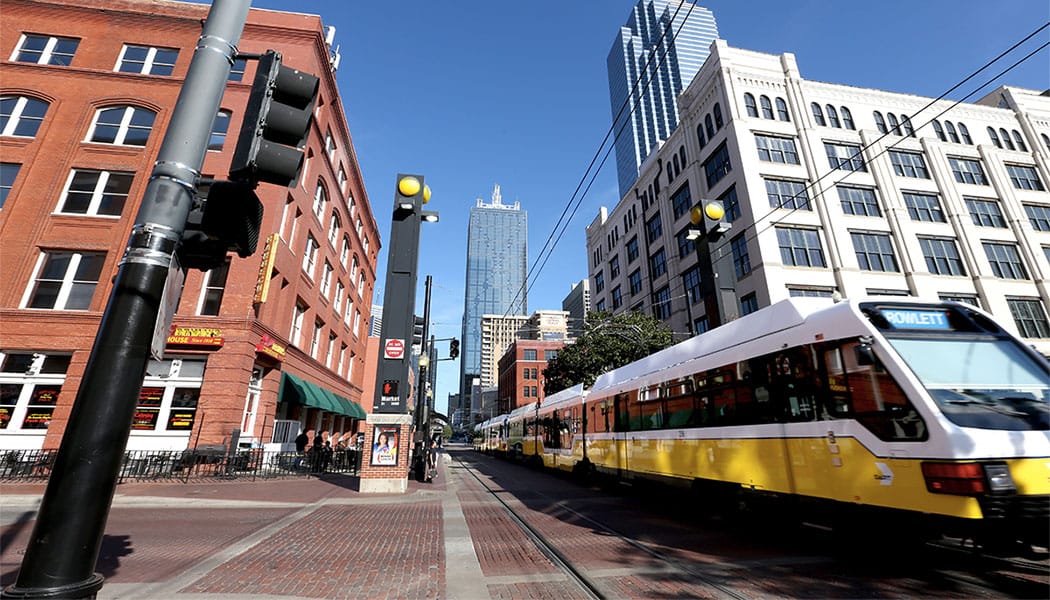
The public transportation system in the City and County of Dallas, Texas consists of a city bus service, streetcar, light rail and commuter rail. I became extremely familiar with each of these transport services during my time visiting Dallas in December 2016. Collectively, I found the Dallas Area Rapid Transit (DART) network to be highly accessible and easy to use. In this section, I will share everything you need to know to use Dallas public transportation with a wheelchair or disability.
Light Rail Trains
DART Light Rail is the easiest way to get around Dallas. The network consists of 4 lines – Blue, Green, Orange and Red – and serves a total of 64 stations. Its 93 miles of track make it the longest light rail system in the United States. The entire system is wheelchair accessible, with station access made possible by elevators and ramps. The majority of downtown stations are at street level.
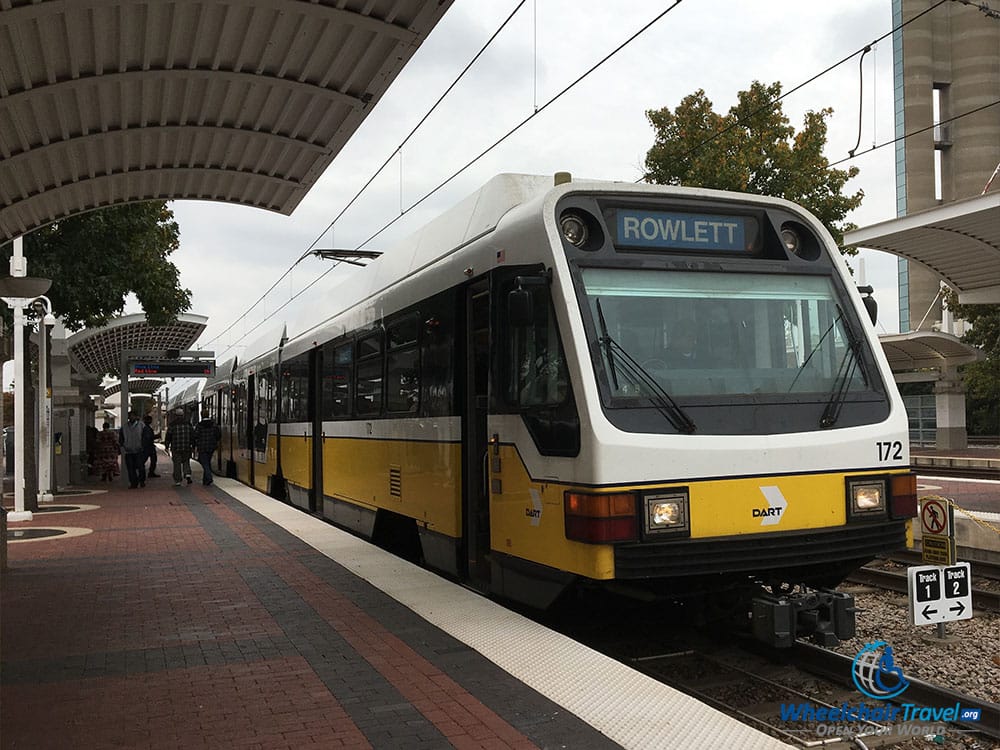
Train cars feature level-entry boarding and a small gap of 2 inches or less between the station platform and train. Inside specially marked cars, reserved spaces for wheelchairs is available. Priority seating for the disabled and elderly is also provided.
For a system map and list of light rail stations, visit www.dart.org.
City Bus
113 wheelchair accessible city bus routes operate throughout Dallas. The buses are modern, with an electronic ramp located at the front door. Two wheelchair spaces on each bus include securement straps.
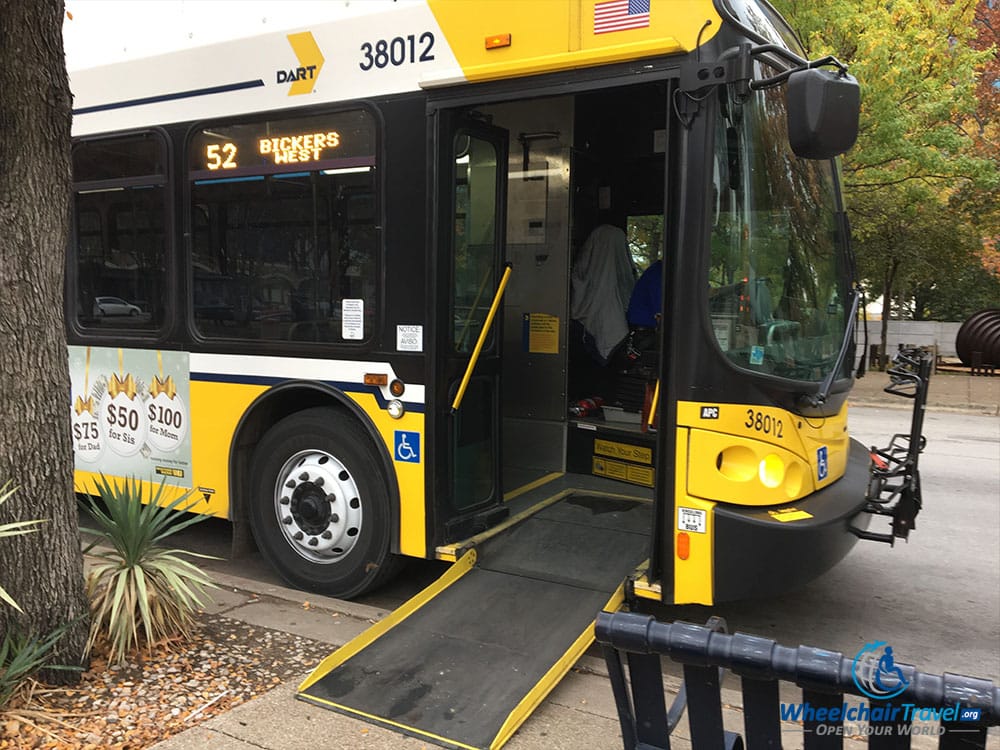
My experience on DART buses was exceedingly positive – drivers were kind, courteous and helpful. I found the buses to run according to the posted schedule, and the routes seemed to be designed for efficiency.
Wheelchair users looking to ride the city bus should flag the driver (raising a hand works best), to notify him/her of your intent to ride. Once aboard, the driver will tie down your wheelchair using securement straps.
An easy to reach stop request button is located in the wheelchair securement area. Press the button as the bus approaches the stop you desire.
For more information on riding the Dallas city buses, or to access a list of routes and maps, visit www.dart.org.
Dallas Streetcar
The Dallas Streetcar is the newest public transportation option in the city, connecting downtown with the Bishop Arts District. The streetcar serves a total of 6 stations, with the terminus ends being Union Station (in Downtown Dallas) and Bishop Arts station, at the heart of the district of the same name.
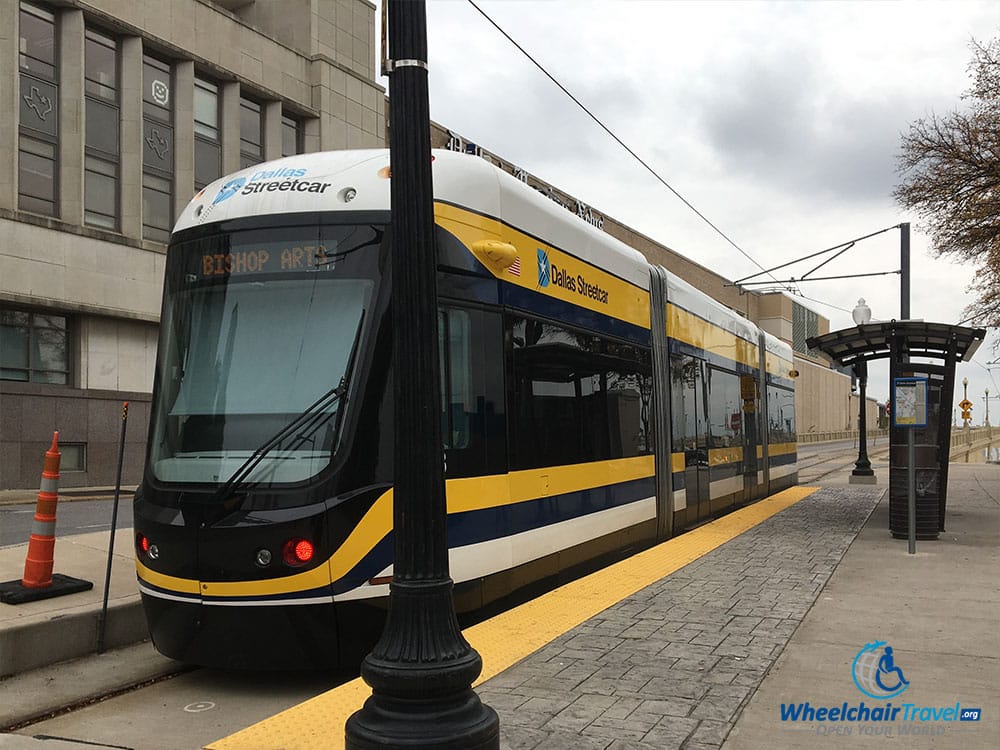
The streetcar is fully wheelchair accessible, with level-entry boarding and a gap of less than two inches between the train and station platform. Spaces reserved for wheelchair users on the streetcar are among the largest I have seen on any public transportation service.
Rides on the streetcar are completely free – there is no fare to be paid! Just hop on and off at your leisure. Trains run every 20 minutes between 5:30 a.m. and midnight. If you are staying in Downtown Dallas, the streetcar is the easiest, fastest and most accessible way to the Bishop Arts District. For more information on the Dallas Streetcar, click here.
TRE Commuter Rail
The Trinity Railway Express, or TRE, is a commuter rail line that connects Dallas and Fort Worth. The TRE is jointly owned by DART and the Fort Worth Transportation Authority.
A single line serves 10 stations, and transit times from end-to-end are just over one hour. In addition to the stop at Union Station in Downtown Dallas, other Dallas TRE stations include Victory (at the American Airlines Arena), Medical/Market Center and the DFW International Airport station.
The TRE is wheelchair accessible, but users will need to flag down the conductor for assistance. Boarding is via a ramp, as the trains are not level with the station platform.
M-Line Trolley
The McKinney Avenue Trolley, or M-Line, is a historic streetcar serving the Dallas Arts District. Due to the age of the vehicles used, there is no wheelchair access possible. Wheelchair users seeking transportation to destinations served by the M-Line should consider using the city bus or DART On-Call services.
For more information on the M-Line Trolley, visit www.mata.org.
Fares & Passes
The easiest way to purchase a fare for the Dallas city bus, light rail or TRE is via the GoPass smartphone app, for iOS and Android devices. To learn more about this app, read my blog article, Mobile App Improves Access to Public Transport in Dallas, Texas.
The above-referenced post is a guide to the features of the application, and describes the benefits of purchasing digital tickets on your phone.
In addition to mobile tickets, you can purchase single-ride fares and day passes at light rail and TRE stations, or directly from a city bus driver. Local and Regional fares are offered. Local fares and passes are valid on DART buses and trains, as well as the TRE between Union Station and DFW Airport. Regional fares and passes are valid on DART buses and trains, the entire TRE service area, as well as The T service in Fort Worth. Fares are priced as follows:
2-hour Pass (Local) – $2.50
Two-Hour Pass (Regional) – $5.00
Two-Hour Pass (Seniors & Disabled) – $1.25
Mid-Day Pass (9:30 a.m. to 2:30 p.m.) – $1.75
Day Pass (Local) – $5.00
Day Pass (Regional) – $10.00
Day Pass (Seniors & Disabled) – $2.50
Riders qualify for the reduced fare, senior and disabled pass if they satisfy one of the following:
- Seniors (65 or older) with a DART photo ID
- Disabled persons with a DART photo ID
- Medicare cardholders
If you are a wheelchair user, you won’t be asked to show ID when using a reduced fare. The discount is a nice way to save a couple dollars a day. For more information on fares, and how to qualify for a reduced fare, visit www.dart.org.
Amtrak at Union Station
Although I have not traveled through the State of Texas on Amtrak, the city is served by the national rail operator. Amtrak’s Texas Eagle service stops at Union Station in Downtown Dallas. The Texas Eagle route connects San Antonio, Texas and Chicago, Illinois, with stops at many points in between, including St. Louis, Little Rock and Austin. For more information on the Texas Eagle service, visit www.amtrak.com.
If you’d like to learn more about riding on America’s railways, read my Wheelchair User’s Guide to Train Travel.
Dallas Wheelchair Taxis
Important information about wheelchair accessible private ground transportation options in Dallas.
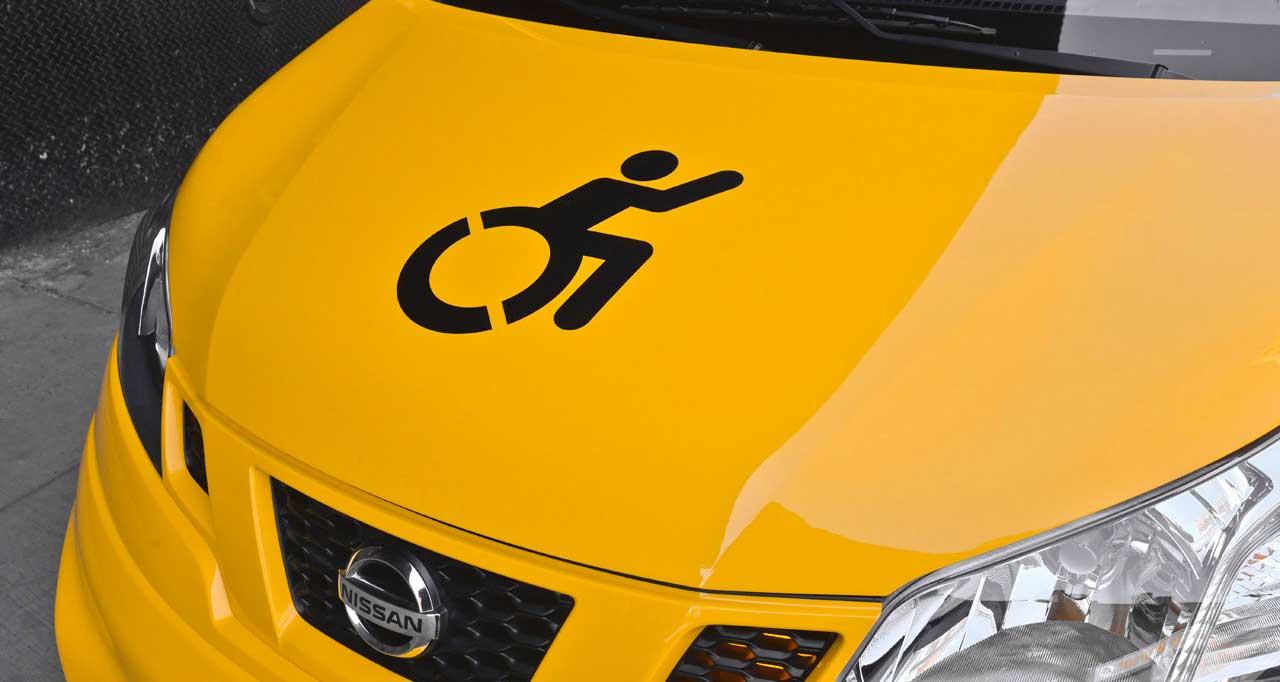
Taxi companies within the City of Dallas do have wheelchair accessible, ramp-equipped taxis. But the situation is complicated.
During my time in Dallas, I made multiple requests for an accessible taxi ride, but was unsuccessful each time. I was repeatedly told that the ADA taxis were already booked or unavailable. My hotel concierge was also unable to secure one for me. My requests occurred at different time periods – morning, afternoon and night. I did, however, see an ADA Yellow Cab taxi picking up a wheelchair user outside Union Station in Downtown Dallas:
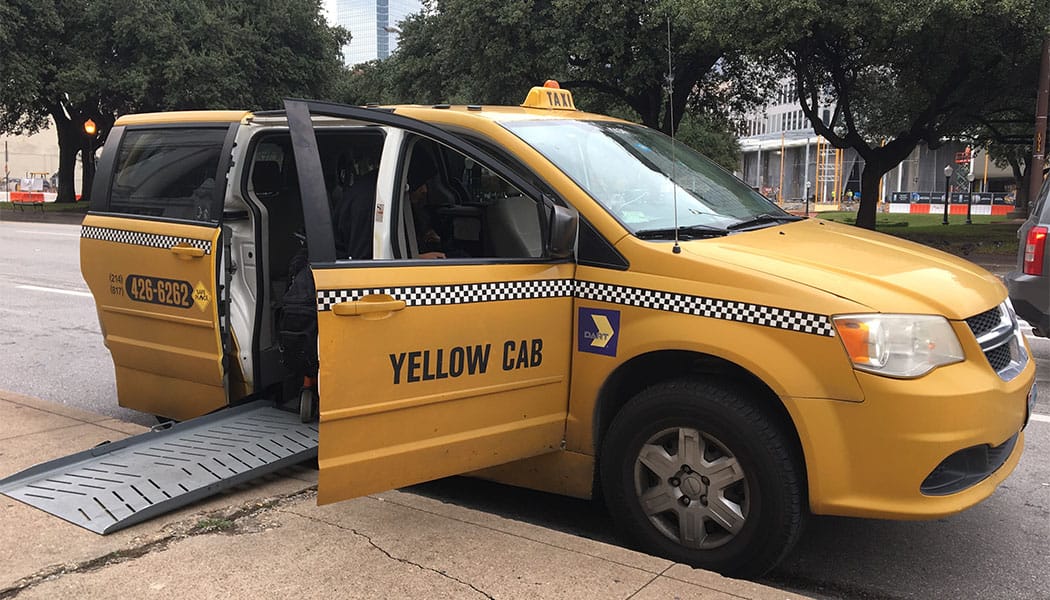
They do exist! But I couldn’t order one, after numerous attempts over the course of a week. So, what’s the deal?
I learned that the ADA taxis in Dallas are contracted out to the city’s paratransit service. This reduces – or in my experience, eliminates – the ability to call an on-demand accessible cab. As you’ll see in the photo above, the ramp-equipped van is owned and operated by Yellow Cab, but has a DART logo sticker on the front fender.
Paratransit services don’t work for many residents. They are rarely practical for wheelchair travelers as tourists. As I wrote in a 2015 blog post, a failure of city governments to enforce the ADA with respect to taxi companies forces the disabled into the shadows.
I plan to reach out to disability groups in Dallas and the city government to see what solutions are being discussed, if any. As with every trip, I look to bring the power of WheelchairTravel.org to improve accessibility in the cities I visit. I hope to have more to report on this matter soon.
In the meantime, if you’d like to try placing an order for an ADA taxi in Dallas, here is the relevant contact information:
Dallas Yellow Cab Co.
www.DallasYellowCab.com
+1 214-426-6262

The Dallas-based company Care Trips offers wheelchair accessible transportation to residents and tourists alike using Dodge Grand Caravan and Toyota Sienna vehicles. Each of the company’s 20 vans has a rear-entry wheelchair ramp and securement straps. The vans can accommodate 2 passengers in addition to the wheelchair user. The fare charged is a $35 base rate, plus $3.50 per mile.
To set-up a ride with Care Trips, utilize the following contact information:
Care Trips
www.CareTrips.net
+1 214-238-9100
CareTrips recommends that reservations be made 12 hours in advance of the trip, but rides can often be accommodated on shorter notice.
Dallas Sidewalk Accessibility
Downtown Dallas is undergoing a massive revitalization, which includes many resurfaced sidewalks and pedestrian zones!
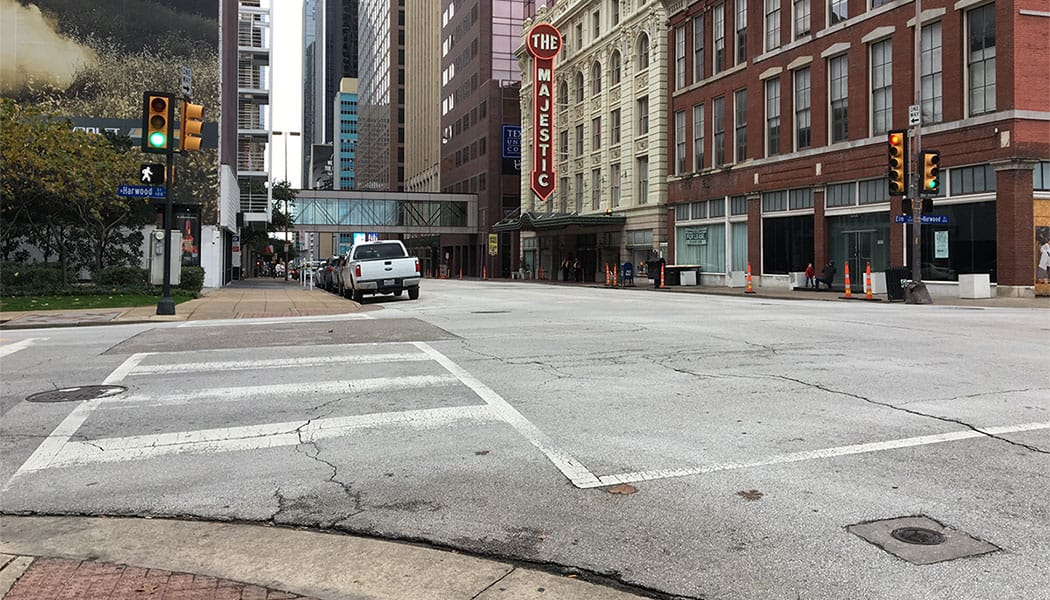
Each time I visit a new city, I make a concerted effort to roll on as many sidewalks as possible. I want to get a very clear understanding of sidewalk accessibility across all areas of the city, but especially those tourists are most likely to encounter. Dallas was no exception, and I believe this section will prepare you for exploring Dallas by wheelchair, “on foot” or “on wheels.”
Downtown is the site of a great deal of construction and revitalization of the city center. Many sidewalks are currently undergoing repairs to make them more accessible to wheelchair users and pedestrians alike. The majority are paved with either cement or a cement mixed with crushed rock. These sidewalks are fairly smooth, though individual slabs are occasionally (or often) uneven, depending on the street. In total, sidewalks in Downtown Dallas are not unlike those found in the majority of other major cities. Because repairs and construction are harder to achieve in urban centers, many sidewalks are in disrepair. Despite these “bumpy” conditions, they remain usable.
Curb cuts or ramps will be found at almost every intersection. During my time in Dallas, across all neighborhoods, I only spotted a few sidewalks without an accessible entryway. Crossing signals mark all of the intersections that have traffic signals for vehicles. Most, but not all, have a pedestrian button that can be pressed. The majority of these are within reach of the sidewalk and easy to use.
Downtown Dallas is, for the most part, flat. This makes rolling in a wheelchair much less stressful for the manual wheelchair user, and better for the battery life of powered chairs. I found some fairly substantial hills in the Arts District and also in the Bishop Arts District. Public transportation is a great way to avoid these barriers, as city buses stop directly in front of popular attractions.
As construction continues, be advised that some sidewalks may be closed or blocked off. Sidewalk closures could add a bit of distance to your walk or roll.
Also understand that my sidewalk review does not take into account the city’s residential areas and suburbs. The purpose of the wheelchair travel guides on this website is not to assess a city’s livability, but to assist wheelchair travelers in planning a temporary visit or tourist itinerary.
Dallas Sidewalk Accessibility
Downtown Dallas is undergoing a massive revitalization, which includes many resurfaced sidewalks and pedestrian zones!

Each time I visit a new city, I make a concerted effort to roll on as many sidewalks as possible. I want to get a very clear understanding of sidewalk accessibility across all areas of the city, but especially those tourists are most likely to encounter. Dallas was no exception, and I believe this section will prepare you for exploring Dallas by wheelchair, “on foot” or “on wheels.”
Downtown is the site of a great deal of construction and revitalization of the city center. Many sidewalks are currently undergoing repairs to make them more accessible to wheelchair users and pedestrians alike. The majority are paved with either cement or a cement mixed with crushed rock. These sidewalks are fairly smooth, though individual slabs are occasionally (or often) uneven, depending on the street. In total, sidewalks in Downtown Dallas are not unlike those found in the majority of other major cities. Because repairs and construction are harder to achieve in urban centers, many sidewalks are in disrepair. Despite these “bumpy” conditions, they remain usable.
Curb cuts or ramps will be found at almost every intersection. During my time in Dallas, across all neighborhoods, I only spotted a few sidewalks without an accessible entryway. Crossing signals mark all of the intersections that have traffic signals for vehicles. Most, but not all, have a pedestrian button that can be pressed. The majority of these are within reach of the sidewalk and easy to use.
Downtown Dallas is, for the most part, flat. This makes rolling in a wheelchair much less stressful for the manual wheelchair user, and better for the battery life of powered chairs. I found some fairly substantial hills in the Arts District and also in the Bishop Arts District. Public transportation is a great way to avoid these barriers, as city buses stop directly in front of popular attractions.
As construction continues, be advised that some sidewalks may be closed or blocked off. Sidewalk closures could add a bit of distance to your walk or roll.
Also understand that my sidewalk review does not take into account the city’s residential areas and suburbs. The purpose of the wheelchair travel guides on this website is not to assess a city’s livability, but to assist wheelchair travelers in planning a temporary visit or tourist itinerary.
Dallas Sports Teams & Stadiums
Information about wheelchair accessibility, seating and tickets at Cowboys, Mavericks, Rangers and Stars games.
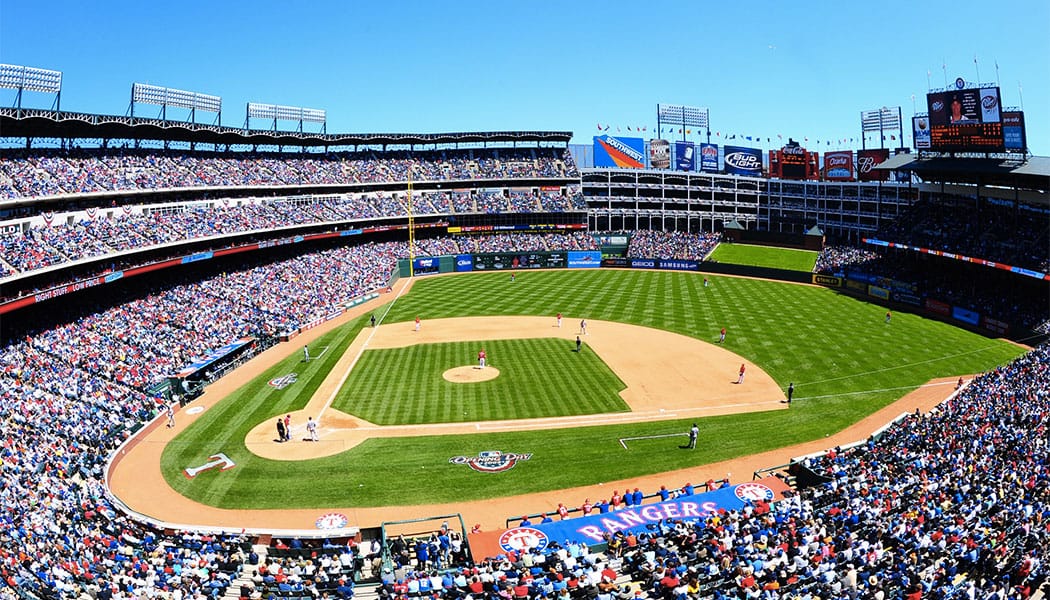
The Dallas Metropolitan Area is home to a wide assortment of professional sports teams, although only two are located inside the city limits. Mark Cuban’s Dallas Mavericks and the NHL’s Dallas Stars both share the American Airlines Arena, which is easily accessible via the city’s DART light rail. The Dallas Cowboys of the NFL and the Texas Rangers of the MLB are located near to the city, but the accessible transit route is longer. Still, each of these teams have arenas and stadiums with accessible seating and wheelchair access. Links to the team-specific accessibility information and ticket office phone numbers are listed below.
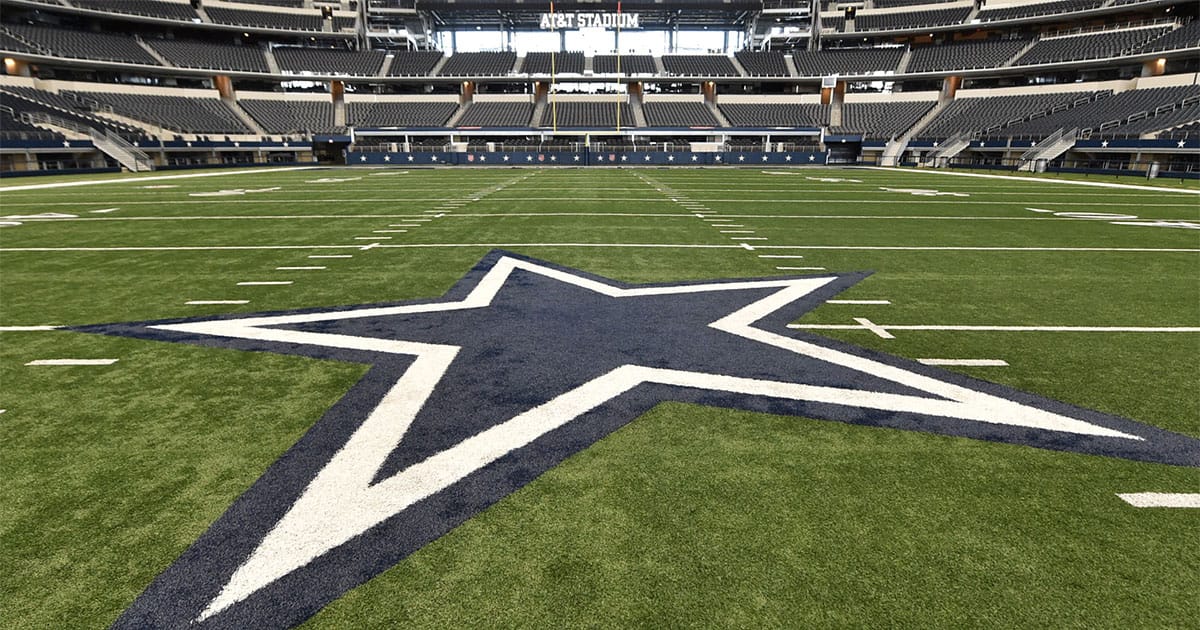
Dallas Cowboys (NFL)
With more fans than any other team in the National Football League, the Cowboys are an important part of Dallas culture and history. The Cowboys play in Arlington, Texas at AT&T Stadium, which is commonly referred to as “Jerry World,” after the team’s owner. The stadium is located at:
1 AT&T Way
Arlington, Texas 76011
AT&T Stadium is served by multiple Metro Arlington Express (MAX) bus routes. These wheelchair accessible city buses offer connections to Centreport Station and the Trinity Railway Express (TRE) train. The TRE offers wheelchair accessible service to Downtown Dallas at Union Station.
For information on ADA seating and tickets, visit www.dallascowboys.com. For additional information on accessibility at the stadium, visit www.attstadium.com.
Dallas Mavericks (NBA)
The National Basketball Association is represented in Dallas by the Mavericks. The team has gained additional attention courtesy of its owner, Mark Cuban, who is one of the stars of ABC’s Shark Tank. The team plays at the American Airlines Center inside the City of Dallas. The arena is located at:
2500 Victory Ave.
Dallas, Texas 75219
American Airlines Center is just steps away from Victory station on the DART light rail. This station and the arena are only a few stops away from the heart of Downtown Dallas. The TRE trains also stop at Victory.
For information on ADA seating and tickets to Dallas Mavericks games, visit www.mavs.com.
Dallas Stars (NHL)
The Dallas Stars is the city’s popular hockey team. Like the Mavericks, the Dallas Stars play at the American Airlines Center. The arena is located at:
2500 Victory Ave.
Dallas, Texas 75219
American Airlines Center is just steps away from Victory station on the DART light rail. This station and the arena are only a few stops away from the heart of Downtown Dallas. The TRE trains also stop at Victory.
For information on ADA seating and tickets to Dallas Stars games, click here.
Dallas Wings (WNBA)
The Wings, formerly located in Detroit and later Tulsa, moved to Dallas for the 2016 season. The Dallas Wings are based at the College Park Center in downtown Arlington, Texas. The arena is located at:
600 S. Center St.
Arlington, Texas 76019
The public transportation route is similar to that for reaching the Cowboys Stadium. From Dallas, take the TRE to Centreport Station and transfer to the appropriate MAX City Bus.
For information on ADA seating and tickets to Dallas Wings games, visit www.wings.wnba.com.
FC Dallas (MLS)
FC Dallas is a Major League Soccer franchise, founded in 1995 as the Dallas Burn. The team is actually based in Frisco, Texas, about 40 miles from Downtown Dallas. FC Dallas plays at Toyota Stadium, located at:
9200 World Cup Way
Frisco, Texas 75033
There are unfortunately no public transportation options between the City of Dallas and Toyota Stadium in Frisco.
For information on ADA seating and tickets to FC Dallas matches, visit www.fcdallas.com.
Texas Rangers (MLB)
Major League Baseball has a home in Dallas with the Texas Rangers. The team played at Globe Life Stadium in Arlington, Texas. If you attend a game, there is a good chance you’ll see the former President of the United States, George W. Bush, in the stands. Globe Life Stadium is located at:
1000 Ballpark Way
Arlington, Texas 76011
From Dallas, take the TRE train to Centreport Station and transfer to one of the MAX city bus routes. This will get you right to the stadium.
For information on ADA seating and tickets to Texas Rangers games, visit www.texas.rangers.mlb.com.
